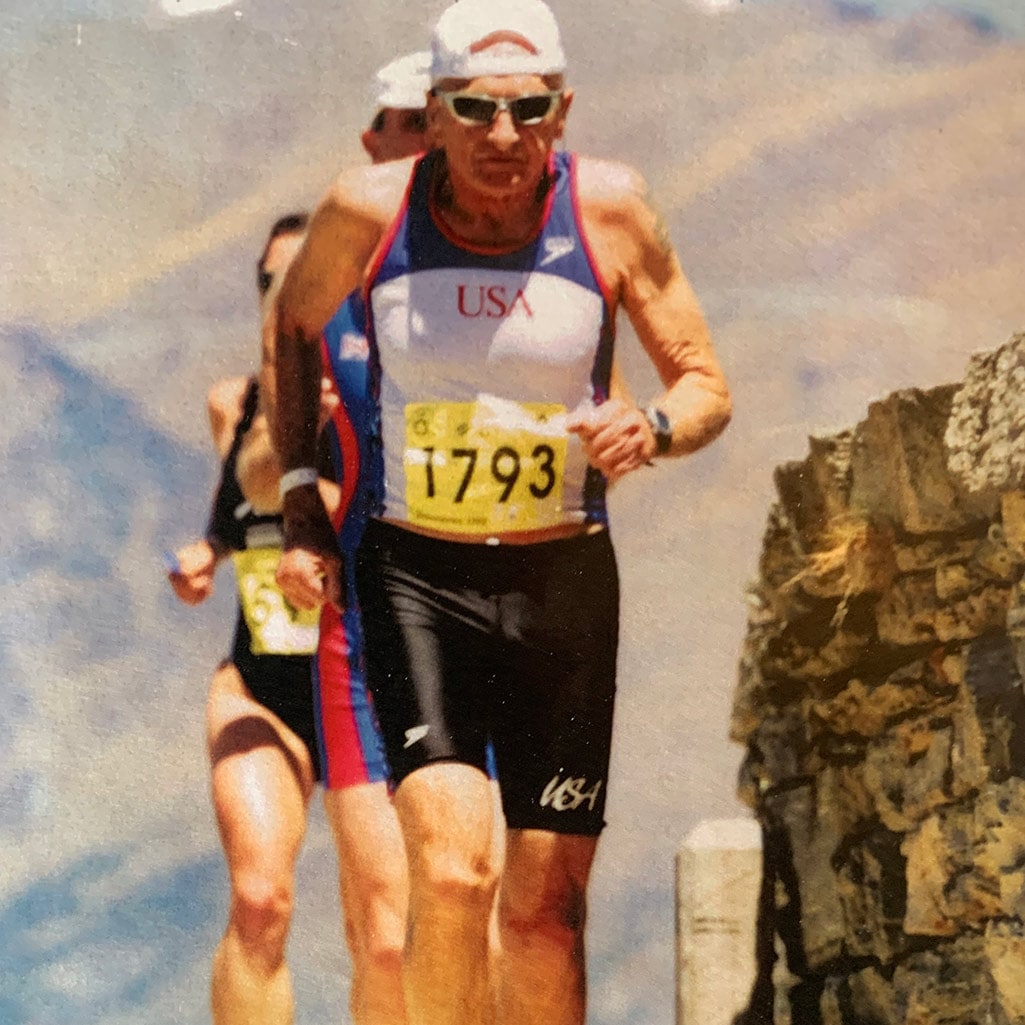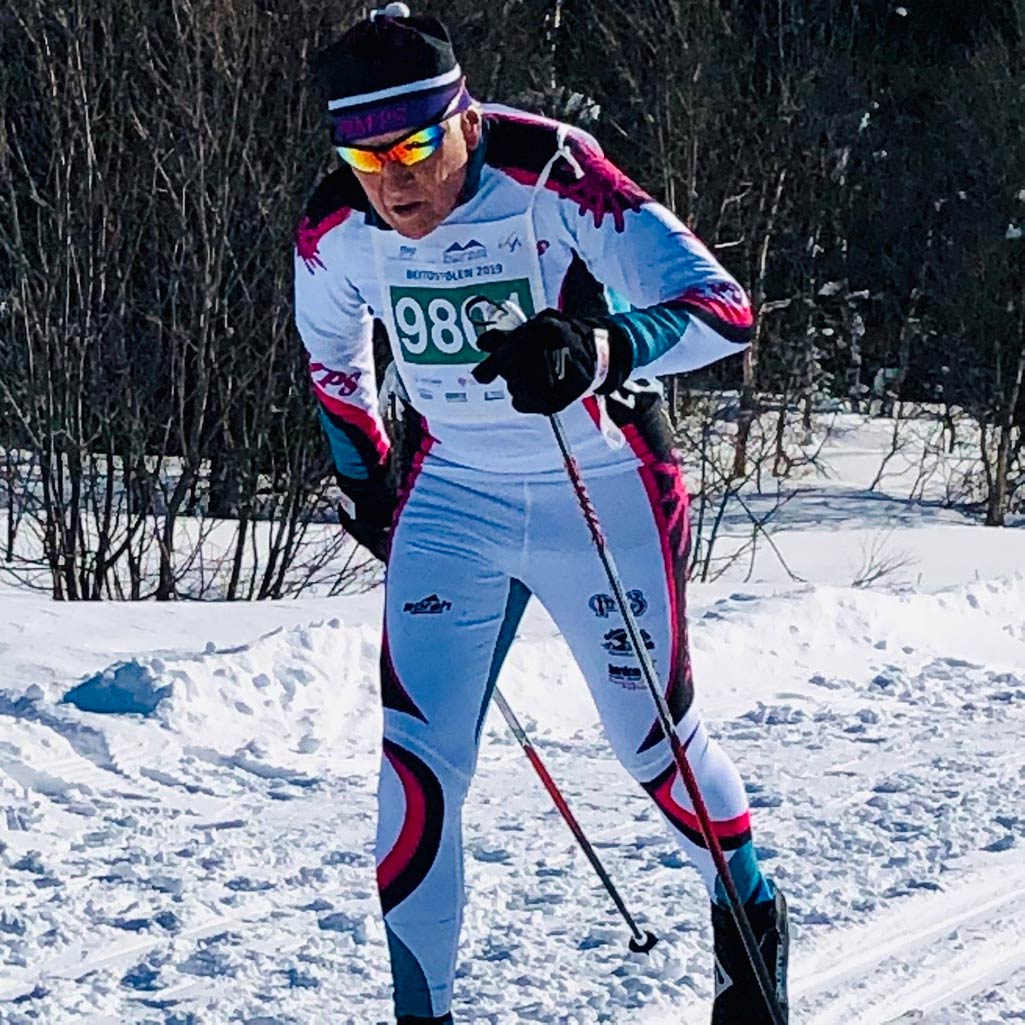One day in October 2019, 93-year-old Charley French packed his wetsuit, running shoes and triathlon kit into a suitcase. He strapped his time-trial bike onto his new car, a bit skeptical that the bike rack’s glorified suction cups would remain attached on the long drive from his home in Ketchum, Idaho, to the race in San Diego. But he didn’t have much choice. When you drive a Lamborghini Gallardo, as French does, bike rack options are limited. “The rack was supposed to be good for 80 mph, but I looked, and I was going 120,” French laughs.
Ever interested in why things succeed, why they fail and what we can do better, French built a career at the intersection of innovation and speed—with a healthy dose of the natural environment he loves thrown in for good measure. Over the decades, his work has touched many of the outdoor world’s core activities. He worked with Bob Smith to create the modern ski goggle and spearheaded the development of Scott’s influential Superlight ski boot. He also helped shape both cycling and triathlon by hammering out a new model of handlebars. French won’t brag about these accomplishments. Play inspired his work, he says, and vice versa. “I decided I love sports,” he says “so I would work in order to go play on the weekends.”
And like that Lamborghini, this REI Co-op Member isn’t keen on slowing down, even at age 96.

How it all started
Charles Sale French was born in St. Louis, Missouri in 1926. In junior high school, his single mother moved him and his two older sisters to Santa Monica, Calif. There he tried out for basketball and football. “I was never any good. I realized that wasn’t me,” he recalls.
As it turned out, neither was formal education. “I was determined not to go to college,” remembers the future engineer. French had a restless mind and thirst for adrenaline. He built a dragster from junkyard parts and raced it on the streets at night, a pastime that led to multiple tickets and an exasperated parent. When French decided to enlist in World War II at 17, an age that needed his mother’s permission, “She said, ‘Where do I sign?’” he laughs.
After the war, French returned to Southern California and spent as much time as possible surfing in Malibu and skiing at Mt. Baldy where he taught skiing. He also gave up his college avoidance and started a degree in engineering. Before he finished, though, he found a job that took him all over Europe, including to Germany. He started making weekend ski trips to Kitzbühel, Austria, where he met an American orthodontist named Bob Smith who shared French’s frustration with inferior ski goggles that let in powder snow.
French had an idea: Why not make goggles more like house windows, heat-sealed and double-paned? They went out and jury-rigged a prototype… that immediately fogged up. French toyed with more prototypes, but he never pursued a patent. Back home, Smith did, and he used nimble-fingered dental students to assemble his new product. Today, the global goggle maker still sends French a free pair each year.
By 1970, at age 44, French was tired of working for the weekend. He moved to Ketchum, home to Sun Valley Resort, in hopes of skiing his beloved moguls daily. Soon he got a job at Scott Sports, and his life would pivot again.

First years as a Scottsman
At the time, Scott, founded by Sun Valley engineer and ski racer Ed Scott, was known for its ski poles. But the company had just purchased patents and manufacturing rights for a ski boot. The deal also came with 1,000 pairs of flawed boots. “I flexed forward, and [the boot] broke,” French recalls.
French and his team dove in to design a better product. They’d start work at 7am, work ’til noon, ski for two hours to test the boot, and return to the office to improve the design. “Every day was another challenge,” he says. “It was a lot of fun.”
Roughly one year and 90 design changes later, French and his team had engineered the Scott Superlight ski boot, designated a factory to make it and built production equipment. The Superlight was a new kind of boot—much lighter and more responsive to what the ski was doing, yet still warm, all of which endeared it to freestyle skiers. “The first time I walked by a sporting goods store in Ketchum, and I saw the pair of boots in the window, I just stopped and stood there for about 20 minutes,” he says. Its lightness also made it terrifying to wear at high speeds, he says, and laughs.
French’s contributions haven’t been limited to skiing. In his 50s, the innovator became friends with Boone Lennon, then head coach of the U.S. Alpine Ski Team. The pair started biking together and competing in the same events. One day, on the ride home from a race, Lennon told French he had an idea for an unusual new handlebar. The design lets a cyclist rest their elbows and hands in front and put the rider in a more aerodynamic tuck. French built the first prototype of his friend’s vision out of wood. They took turns bolting the crude device to their bikes; test rides by the men showed that it could make a cyclist faster.
Aero Dynamo
Plenty of triathletes shook their heads in 1986 when French, then age 60, showed up at the Ironman World Championship in Hawaii sporting the now-aluminum aero bars, shaped like a bent U, on the front of his bike. French won his age group. The triathletes stopped laughing.
Dedicated bike racers were a harder sell. “We tried to get guys to use the bars,” French says, “but no bike racers would use them.”
By 1989 Lennon had acquired a patent for the aero bars through Scott. French crafted a new pair and flew them to Lennon in Europe during the Tour de France. Lennon showed them to the top American rider in the Tour, Greg LeMond, who accepted the offer to use the handlebars.
Before the time trial on the race’s final day, LeMond trailed French front-runner Laurent Fignon by 50 seconds. LeMond decided to try the aero bars. LeMond won the stage and won the Tour by just 8 seconds—the narrowest margin in Tour history.
“After that, every bike racer wanted to use the bars,” French says. Even today, though, he won’t brag about it. “It was Boone’s idea,” says the nonagenarian.
Shifting gears
After hitting 50 in the mid-1970s and realizing he no longer was getting better at activities that he loved, such as mogul skiing, French shifted gears. He began to cross-country ski in earnest, and to pursue triathlons—moving from the thrill sports to the “pain sports,” as he likes to call them.
As he showed with his Ironman win, he’s embraced the pain. Over the following decades, French claimed five age-group world titles in triathlon and seven Masters World Cup medals for his age group in cross-country skiing, not to mention scores of other trophies.
These days, the Masters athlete still rides his bike and swims regularly. He spends several days a week on the cross-country ski trails, training for his next race. (He’s signed up for the Masters World Cup 2023 in Austria). Last February, French competed at the “The Charley Course Half-Boulder,” the 15-kilometer version of the longer Boulder Mountain Tour, a long-running Nordic ski race in Utah that he participated in for so many decades that organizers named the shorter race for him. This year, he won his division again—but at his age, he says, “of course, I was the only one in my age group.”
Those groaning shelves of awards are not only a testament to French’s determination to improve as an athlete but to keep evolving as a person, say those who know him. “He’s always pushing to be better,” says Muffy Ritz, a former Olympic Nordic skier and close friend.

Learning from a legend
French isn’t sure there’s a secret to his longevity as an athlete, but he has a few suggestions.
One is to embrace the gym. French always hated weight training, but he begrudgingly took it up in his 70s—half-hoping it wouldn’t work and he could stop, he jokes. Alas, pumping iron bore results. “A year later, my triathlon times were better, and my swimming times were better, and I said, ‘Oh man, this is not good!” he says. “And unfortunately, I’m still there in the gym.” He also eats well and enjoys training generally.
Still, he attributes much of his athletic longevity to good fortune. “It’s luck how good your body is, how much energy you have, how much desire you have to do things,” he says. “You can alter these to some degree, but I’ve just been lucky.”
French says he has slowed down a bit in the last few years compared to when he was in his 80s. He’s starting to feel his strength and stamina decline a bit. He thinks: “Huh, maybe I’m getting old.”
Old is relative, though. French still participates in multi-day guided bike tours. He’s training for a bike trip in Portugal next summer. He’s still driving that Lamborghini to the trailhead, his skinny skis in the passenger seat, tips sticking out the window.
It’s crucial to have goals, French says. “Every day you have to have projects, no matter what they are.” Goals keep you focused; they keep you positive. “If you’ve trained hard, and you think you’ve done everything right, even if you don’t win, you’ll feel good,” he explains.
French was talking about his approach to training for triathlons but he could have been advising an approach to life.

